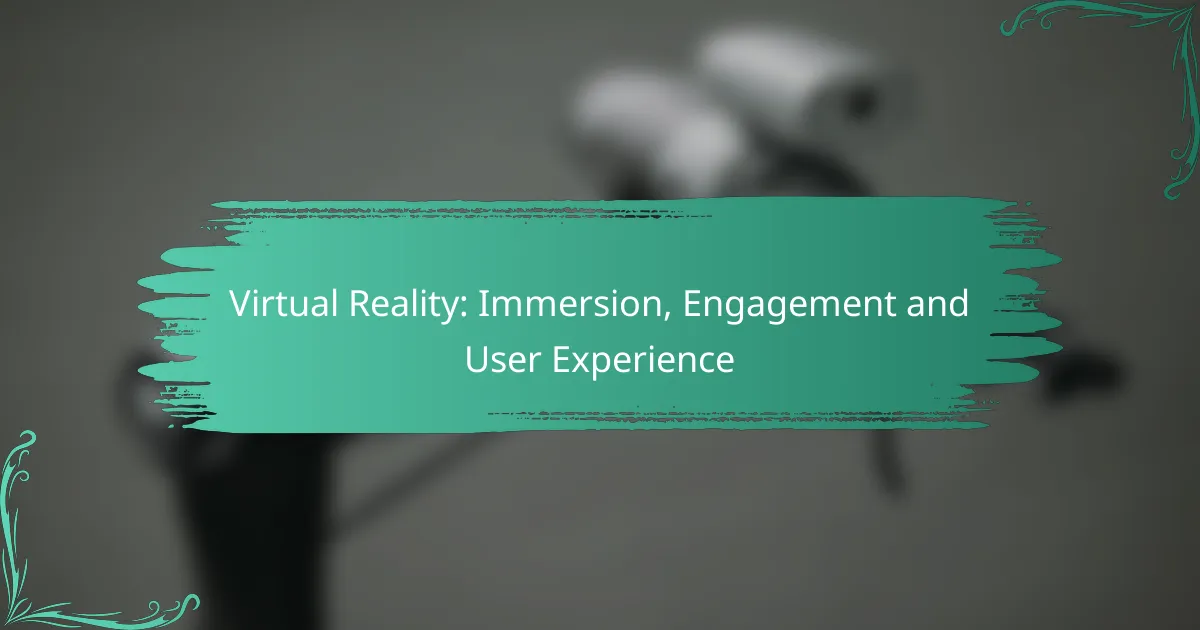Virtual reality (VR) revolutionizes user experience by offering immersive environments that engage and captivate users on multiple sensory levels. By combining high visual fidelity, realistic audio, and haptic feedback, VR creates compelling experiences that foster deeper emotional connections and enhance participation across various industries, including gaming, healthcare, and education.
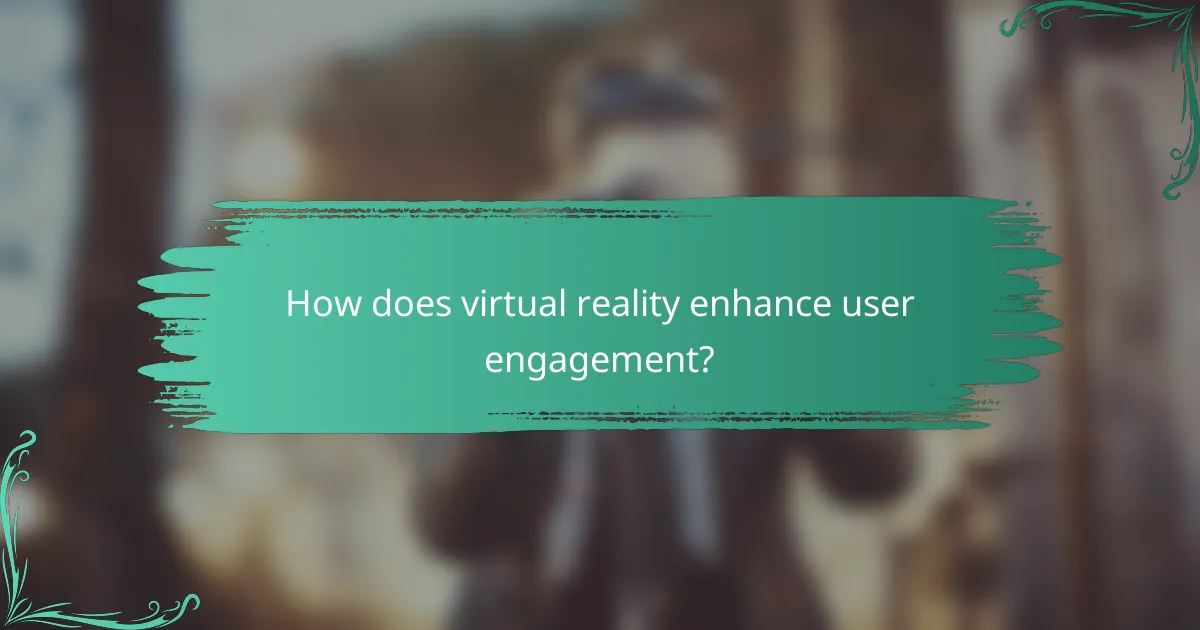
How does virtual reality enhance user engagement?
Virtual reality (VR) enhances user engagement by creating immersive environments that captivate users’ attention and stimulate their senses. This technology allows users to interact with digital spaces in ways that traditional media cannot, leading to deeper emotional connections and increased participation.
Immersive experiences
Immersive experiences in VR transport users into lifelike environments, making them feel as if they are part of the action. By utilizing high-quality graphics, spatial audio, and haptic feedback, VR can simulate real-world scenarios, enhancing the sense of presence. For instance, users can explore virtual worlds, attend events, or even practice skills in a safe, controlled setting.
To maximize immersion, developers should focus on creating realistic visuals and sounds that align with user expectations. This can include detailed environments, responsive interactions, and minimizing latency to avoid motion sickness.
Interactive elements
Interactive elements in VR allow users to engage actively with the environment, rather than passively observing. Users can manipulate objects, make choices, and influence outcomes, which fosters a sense of agency and investment in the experience. For example, in a VR training simulation, users can practice procedures by interacting with virtual tools and equipment.
When designing interactive elements, it’s crucial to ensure that controls are intuitive and responsive. Providing clear instructions and feedback can enhance user satisfaction and encourage exploration within the virtual space.
Social connectivity
VR enhances social connectivity by enabling users to interact with others in shared virtual environments. This can include multiplayer games, virtual meetings, or social hangouts, where users can communicate and collaborate in real-time. Such interactions can lead to stronger relationships and a sense of community, even when participants are physically distant.
To foster social connectivity, platforms should incorporate features like voice chat, customizable avatars, and shared experiences. Ensuring a user-friendly interface can help users feel more comfortable engaging with others in VR.
Gamification techniques
Gamification techniques in VR leverage game design elements to enhance user engagement and motivation. By incorporating challenges, rewards, and progress tracking, users are encouraged to participate more actively and persistently. For example, educational VR applications can use quizzes and achievements to motivate learners.
When implementing gamification, it’s important to strike a balance between fun and functionality. Overly complex systems may frustrate users, while simple rewards can keep them motivated. Regularly updating content can also maintain interest and encourage continued engagement.

What are the key components of immersion in virtual reality?
The key components of immersion in virtual reality (VR) include visual fidelity, audio realism, and haptic feedback. These elements work together to create a convincing and engaging experience that can transport users to different environments and scenarios.
Visual fidelity
Visual fidelity refers to the quality and realism of the graphics in a virtual environment. High-resolution textures, realistic lighting, and smooth frame rates contribute to a more immersive experience. Users typically prefer resolutions of at least 1080p, with many headsets now offering 4K or higher for enhanced clarity.
When designing or selecting VR content, prioritize environments that are visually rich and detailed. Avoid low-resolution graphics, as they can break immersion and lead to discomfort. Consider the hardware capabilities, as higher fidelity requires more powerful systems.
Audio realism
Audio realism involves the use of spatial audio to create a sense of presence within the virtual environment. Sounds that come from specific directions and distances enhance the feeling of being in a real space. Implementing 3D audio techniques can significantly improve user engagement.
Choose audio systems that support surround sound or binaural audio for the best results. Ensure that sound effects are synchronized with visual cues to maintain immersion. Avoid flat or poorly mixed audio, as it can detract from the overall experience.
Haptic feedback
Haptic feedback provides tactile sensations that mimic real-world interactions, enhancing the sense of presence in VR. This can include vibrations, pressure, or resistance felt through controllers or wearable devices. Effective haptic feedback can make actions like grabbing or touching objects feel more realistic.
When developing or using VR applications, incorporate haptic feedback to reinforce interactions. Ensure that the feedback is timely and relevant to the user’s actions. Avoid overusing haptics, as excessive feedback can lead to confusion or discomfort.
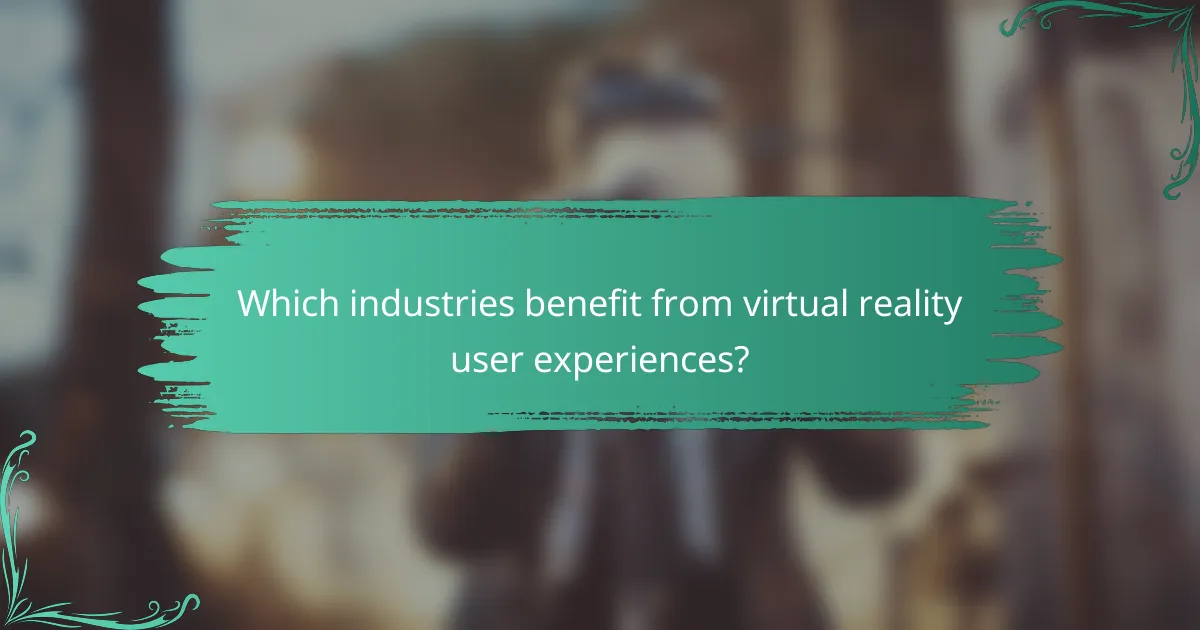
Which industries benefit from virtual reality user experiences?
Virtual reality (VR) user experiences significantly enhance various industries by providing immersive and engaging environments. Key sectors such as gaming, healthcare, and education leverage VR to improve user interaction, training, and overall effectiveness.
Gaming industry
The gaming industry is one of the most prominent beneficiaries of virtual reality. VR technology allows players to immerse themselves in lifelike environments, enhancing the overall gaming experience. Popular VR games often feature interactive elements that respond to player movements, creating a more engaging and realistic gameplay.
Developers must consider hardware compatibility and user comfort when designing VR games. Ensuring that the experience is accessible on various VR headsets can widen the audience. Additionally, maintaining a balance between graphics quality and performance is crucial to avoid motion sickness.
Healthcare applications
In healthcare, virtual reality is transforming training and patient treatment. Medical professionals use VR simulations to practice surgical procedures, allowing for hands-on experience without risk to patients. This method can significantly reduce training time and improve skill retention.
Moreover, VR is utilized in therapeutic settings, such as exposure therapy for phobias or PTSD. By creating controlled environments, therapists can help patients confront fears safely. However, practitioners should ensure that VR experiences are tailored to individual needs for maximum effectiveness.
Education and training
Virtual reality in education offers immersive learning experiences that enhance student engagement and retention. Subjects like history or science can be brought to life through VR, allowing students to explore environments or scenarios that would be impossible in a traditional classroom.
When implementing VR in educational settings, institutions should focus on content quality and accessibility. Providing a range of VR experiences can cater to different learning styles. Additionally, educators should be trained to integrate VR effectively into their teaching methods to maximize its potential benefits.
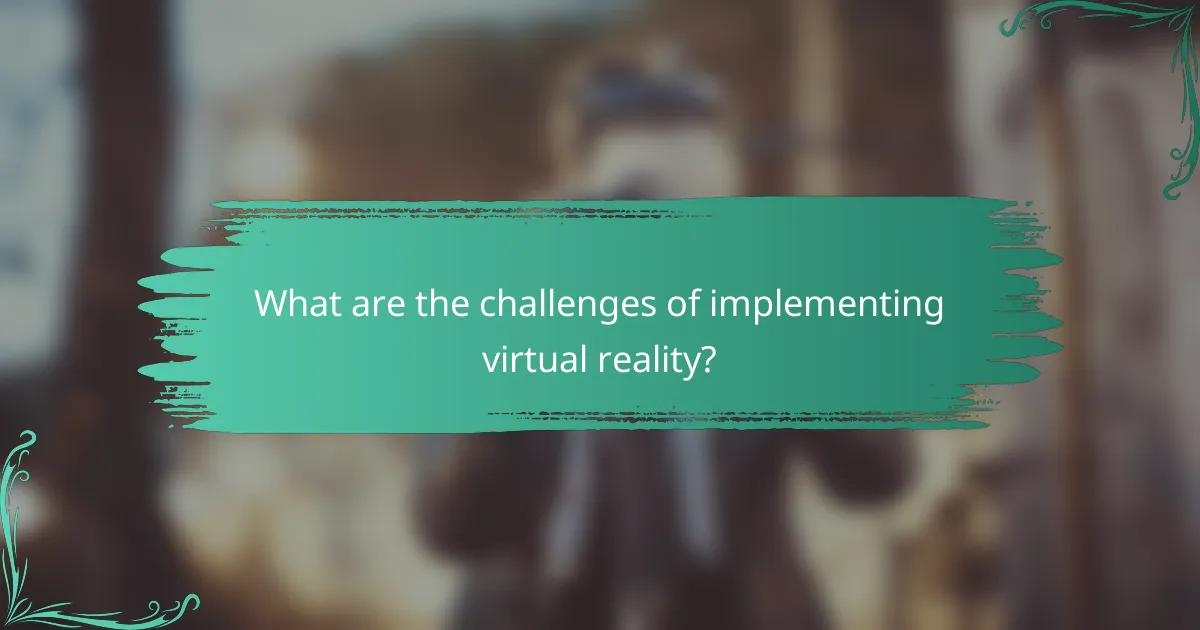
What are the challenges of implementing virtual reality?
Implementing virtual reality (VR) involves several challenges that can hinder its adoption and effectiveness. Key obstacles include high hardware costs, complex content creation, and user accessibility issues.
High hardware costs
The initial investment for VR hardware can be substantial, often ranging from hundreds to thousands of dollars depending on the system. High-quality headsets, powerful computers, and additional accessories contribute to these costs, making it less accessible for casual users and small businesses.
Organizations must weigh the benefits of VR against these expenses. For instance, while VR can enhance training and simulations, the financial commitment may not be feasible for all companies. Exploring financing options or phased implementations can help mitigate upfront costs.
Content creation complexity
Creating engaging VR content is a complex process that requires specialized skills and tools. Developers need to understand 3D modeling, animation, and interactive design, which can significantly extend the development timeline and increase costs.
Moreover, ensuring that the content is immersive and user-friendly demands extensive testing and iteration. Companies may consider partnering with experienced VR developers or using existing platforms that simplify content creation to overcome these challenges.
User accessibility issues
User accessibility in VR is a pressing concern, as not all individuals can easily use VR systems. Factors such as physical disabilities, motion sickness, and age-related challenges can limit participation and engagement.
To address these issues, developers should prioritize inclusive design practices, such as adjustable settings for comfort and alternative control schemes. Offering tutorials and support can also help users acclimate to VR environments, enhancing overall user experience.
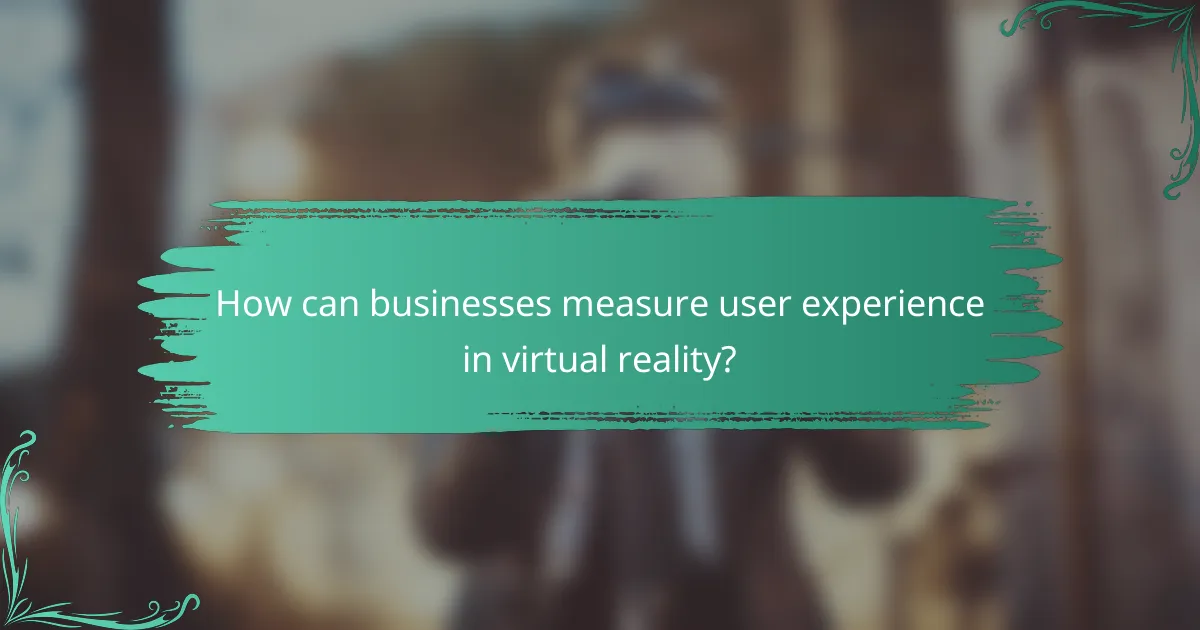
How can businesses measure user experience in virtual reality?
Businesses can measure user experience in virtual reality (VR) through various methods that provide insights into user satisfaction and engagement. Key approaches include user feedback surveys, analytics and engagement metrics, and behavior tracking, each offering unique perspectives on how users interact with VR environments.
User feedback surveys
User feedback surveys are essential for gathering direct insights from participants about their VR experiences. These surveys can include questions about usability, enjoyment, and overall satisfaction, helping businesses identify strengths and weaknesses in their VR applications.
To maximize the effectiveness of surveys, consider using a mix of open-ended and closed questions. This allows users to express their thoughts while also providing quantifiable data. Aim for a response rate of at least 20-30% to ensure a representative sample.
Analytics and engagement metrics
Analytics and engagement metrics provide quantitative data on how users interact with VR content. Metrics such as session duration, frequency of use, and completion rates can reveal patterns in user behavior and highlight areas for improvement.
Utilizing tools that track these metrics can help businesses understand user engagement levels. For example, if users frequently exit a VR experience early, it may indicate issues with content quality or user interface design. Regularly reviewing these metrics can guide iterative improvements.
Behavior tracking
Behavior tracking involves monitoring specific user actions within the VR environment, such as gaze direction, movement patterns, and interaction frequency. This data helps businesses understand how users navigate and engage with their VR experiences.
Implementing tools that provide heatmaps or interaction logs can visualize user behavior, making it easier to identify popular features or problematic areas. Be mindful of privacy concerns and ensure compliance with relevant regulations when collecting and analyzing user data.
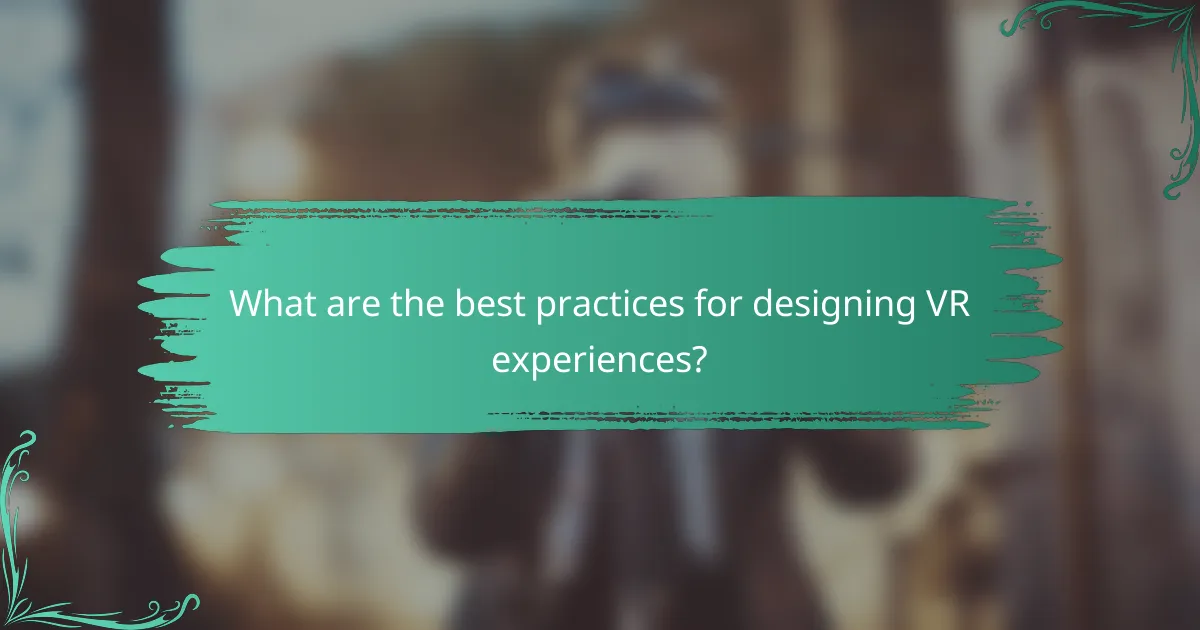
What are the best practices for designing VR experiences?
To create effective virtual reality (VR) experiences, designers should prioritize user engagement and immersion through thoughtful design choices. Best practices include understanding user needs, ensuring intuitive interactions, and optimizing the sensory experience.
User-centered design
User-centered design focuses on the needs, preferences, and limitations of the end-users throughout the VR development process. This approach ensures that the experience is tailored to the target audience, enhancing both usability and satisfaction.
Key steps in user-centered design include conducting user research, creating personas, and testing prototypes with real users. Engaging users early and often helps identify potential issues and refine the experience based on feedback.
Common pitfalls to avoid include neglecting user feedback and assuming that what works in traditional media will translate directly to VR. Instead, prioritize iterative testing and be willing to adapt based on user insights to create a more engaging and immersive experience.
